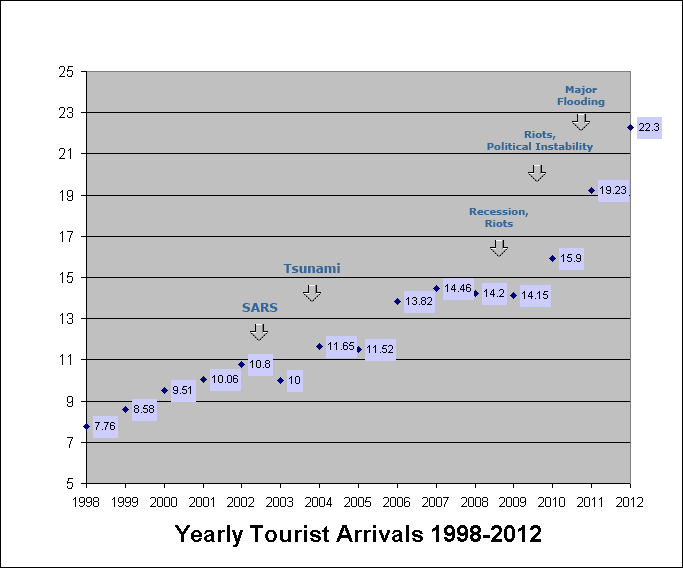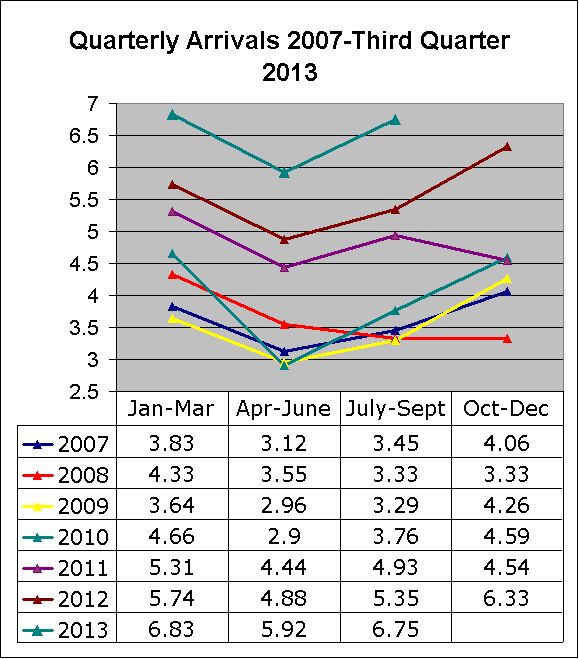Last update this page : 22 October 2013.
Short comment : Arrivals first three quarters of 2013 highest ever at 19.67 million visitors (23% higher than in 2012)
See quarterly data from 2007 till now at bottom of this page. 2012 saw the highest number of arrivals yet at 22.3 million arrivals. 2013 is well under way to be an even (much) better year.
At bottom of this page : current problems with tourism to Thailand. See also these separate pages :
Tourist arrivals by Region and Nationality. Growth markets | Revenue from Tourism by Visitor's Country of Origin
[previous content of this page, about the effect of the tsunami on tourism, has moved]
International arrivals to Thailand from 1998 to 2012 show a significant rise from 1998 onwards. There are significant dips with the SARS epidemic, and after the Tsunami of end 2004. Global recession (from end 2008), political disturbances in 2009 and 2010, and certainly the floods end 2011 had a major effect on tourist arrivals. [See chart below]. Despite the latter untoward event, when most of Central Thailand and parts of Bangkok were flooded for many weeks, tourism arrivals in 2011 broke all records. This trend has continued unabated, and 2012 saw a record 22.3 million arrivals. This when the floods end 2011 presumably still had an effect on arrivals during the first quarter of the year.
The Office of Tourism Development provides arrival statistics. The excel files on the website provide data in English, but navigation to get there is in Thai language only.

|
Since somewhere in the middle of 2008 a severe worldwide recession dampened the desire to travel. Thailand furthermore suffered from political instability, starting with the closure of Suvarnabhumi Airport (26 november 2008, by the Yellow Shirts protesters). A Red Shirt mob invaded the East Asia Summit in Pattaya on 11 April 2009, leading to a cancellation of the summit, with world leaders scurried away to safety. This was followed by violent riots the next day (during Songkhran) and the declaration of a state of emergency by prime minister Abhisit Vejjajiva.
On top of all that, flu cases emerged in March and April of 2009 in Mexico, with the official first announcement of the new H1N1 flu on 23 April. On 12 May, it was made public by Health Minister Witthaya Kaewparadai that two Thais who returned from Mexico had been infected with swine and subsequently recovered. Fortunately while infections became epidemic, the resulting health risk of H1N1 infection proved to be less serious than expected by some.
The graph above shows the evolution of international visitors to Thailand between 1998 and 2012. We made the graph but the data come from the Tourism Authority of Thailand.
Despite the serious disturbances in April 2009, tourism arrivals for the whole year were only mildly affected, with a significant upturn (+28%) in the last quarter of 2009, when compared to the last quarter of 2010.
Serious demonstrations by the Red Shirts happened in April and May 2010. Rioters occupying a large area in the center of Bangkok's shopping district were dispersed (with many casualties). This was world-news and had serious consequences for the tourism industry during the second quarter.
However, arrivals during the third and final quarter of 2010 saw much increased tourist arrival numbers (see chart at bottom), and the year 2010 in total shows the highest number on record till that time.
The downturn in the second quarter of 2009 was expected by the prime minister (as reported in April 2009) to cost the country something like 4 billion U.S. Dollar. Likely, in 2010 a similar amount of money was lost for the tourism industry.
The first 9 months of 2011 turned out to be a bumper year for tourism. Data for the whole year show arrivals going off the chart with 19.2 million visitors. If not for the flooding of large parts of the country, the number would clearly have gone pass the 20 million mark. We estimate opportunity loss to the tourism industry at between 1 and 2 billion U.S. dollars. Despite the bumper year, there still is a lot of complaints from the industry, but we guess, business people can never be fully satisfied. |
In the recent past, both SARS in early 2003, and the Tsunami of december 2004, had significant effects on the number of international arrivals. Bird flu also emerged at the beginning of 2004 in Thailand and probably with the Tsunami, caused a decreased number of visitors in the 2004-2005 period.
The health scare (and tsunami) had a much larger impact on tourist arrivals than the political events during 2009 and 2010.
Tourism Industry in Thailand
Thailand's tourism industry makes up about 6.5 percent of the country's GDP. When seeing the number of tourists, and the number of tourist destinations and hotels, one would actually expect a more substantial portain of GDP. But Thailand's tourism industry, while very visible, brings in much less money than other service industries, and certainly less than its manufacturing industry.
Nevertheless, international visitors spent more than 547 billion baht (something like 16 billion U.S. Dollars) in 2008. The average length of stay per tourist in 2007 was 9 days.
Interestingly, the tourism sector does not only depend on foreign visitors. The number of domestic tourists actually dwarfs the number of foreign tourists. But domestic tourists (mostly Thais) do spend much less per day and their trips are shorter, on average two days and a half. In 2007 there were reportedly more than 83 million in-country travel trips. This created 380 billion baht in revenue.
Average daily expenditure was around 1770 baht per person in 2007 (as compared to 4120 baht per person for international tourism).
Updates on tourism income and arrivals by nationality and region for 2012.
Arrivals from 2007 till third quarter of 2013 :
The number of tourist arrivals in the first quarter and second quarter of 2009 were 3,64 million and 2,96 million respectively. These figures were lower than during the first 2 quarters of 2007 or 2008. In the third quarter of 2009 we see that the number of visitors is similar to the number of visitors in both 2007 and 2008, suggesting that the worst was over. In the 4th quarter of 2009, we saw more arrivals than in 2007 and 2008. See the yellow line crossing over in the graph below.
The first quarter of 2010 saw a significant increase of tourist arrivals, especially in January and February.
Related to the political disturbances during April and May 2010, the second quarter arrivals of 2010 were low (but not much lower than in the second quarter of 2009, which also was characterized by riots and demonstrations. However, tourism rebounded strongly during the third and fourth quarter of 2010, with arrivals higher than in any of the preceding years. The highest number ever of arrivals is in the most recent period : the first quarter of 2011 (at 5.33 million visitors). The second quarter of 2011 saw a 50% increase when compared to the second dismal quarter of 2010.
We figure that Thailand missed out on in between 1 and 2 million potential extra visitors in both 2009 and 2010. Total arrivals for 2010 where the highest on record, despite the actually very serious political disturbances in the second quarter of the year. Except for the second quarter itself, all the other quarters of 2010 show numbers higher than before.
It is interesting to know that negative factors seem to loose influence in just 2 to 3 months each time, with visitors resuming their interest in Thailand as a major tourist destination thereafter.
2011 was the best year for tourism on record. That even with the negative impact of the severe flooding in September, October and November. However, 2012 turned out to be even (much) better. The last quarter of 2012 saw also the most visitors ever to the country. Clearly, the hotel industry still expects much more arrivals, if we have to believe that certain hotels still complain of low occupancy (and therefore less than 'optimal' booking rates).
The first three quarters of 2013 show the highest number of arrivals yet. Heading towards 25 million visitors in 2013? |

Numbers show number of tourist arrivals (in millions).
Dates of political unrest and untoward events :
2009 : most negative events 11-12 April
2010 : most negative events : around 19 May
2011 : flooding of Central Thailand and part of Bangkok Oct-Dec
Current problems with tourism to Thailand :
The number of arrivals of tourists to Bangkok and Thailand is ever rising. The flipside is that more and more (relatively unskilled and low-paid) employees are dependent on the tourism industry.
In 2012 there are at least two problems that are unlikely to be solved soon :
1) Suvarnabhumi Airport is at or above capacity. Plans are there for expansion and this will surely happen but will take time. The old international airport Don Muang is being upgraded and is used for budget and in-country flights. Since there is no fast link from the new to the old airport, at one point this may create problems with incoming international passengers, who need connecting flights.
Visitors not likely will see the logistics behind an airport working at full capacity, except notice that the airport is a busy place. What is a bit related, though not fully, are the poor immigration services. On repeated occasions, this has made headline news locally. Long queues are created for both outgoing and incoming passengers. What is most disturbing, is that visitors can notice long queues on the one hand, and empty immigration boots on the other hand, that is, not enough immigration officers are working at busy times. The immigration officers reportedly also complain about a stressful situation. At one time, a 'fast track' for paying visitors was heavily promoted, which really was borderline ridiculous.
It has to be said that immigration procedures have changed over the last few years, and are a bit more time-consuming. Photographs are taken, and it won't be long before everybody gets fingerprinted.
End 2012, beginning 2013 the problem seems to have improved a bit, less complaints in the Thai English-language media.
The advice : arrive at the airport well on time.
2) For YEARS, Chiang Mai and surrounding areas have made the news with complaints of hazy skies, and dangerously high particle levels in the air. This year again (the period of the year when it occurs seems to be between Januari and April) air pollution levels (yes, quite a few people need hospital treatment) remained poor for many weeks. The reason is the rather medieval practice of burning waste of farm crops. Mostly in Thailand, also in neighboring Burma. On top of that, companies have been accused of burning forest land, to prepare it for planting crops to be used for alternative fuel production. The irony of this statement should not be lost on anybody.
What is most disturbing is that this problem has been there for many years now, and often reported, at least in the local press, but there seems to be no relevant action taken against waste burning. I guess, nobody wants to upset the farmers.
2013 shows the same problem persisting with slightly less coverage in the media though.
The advice : Check-out the situation before travelling to Northern Thailand in the early months of the year.
Charts copyright ThaiWebsites.com
|